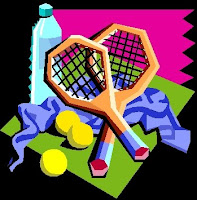
Have you ever played a match that moves way too fast? You think you'll warm up any minute now and get a rhythm going. Next thing you know, you're down a set, its match point and you just lost by hitting your return WAY out! Did two sets really go by that quickly?
If you often get the feeling you've been "rushed" through a match, you need to come up with some acceptable ways to slow down the other team's pace and momentum. I'm not talking about gamesmanship or pretend bathroom breaks. Rather, you need to be aware of those opportunities that you are afforded in any match, by rules, regulations, etiquette, whatever, to regain your composure, calm down, and get a grip on what's happening on the court.
So what are some acceptable ways to slow down the pace in a match?
The rules of tennis provide help here. Let's assume the ITF's Rules of Tennis apply (which they should). Rule 21 states:
The server shall not serve until the receiver is ready. However, the receiver shall play to the reasonable pace of the server and shall be ready to receive within a reasonable time of the server being ready.
So when you're the server, you set the pace and it should be a "reasonable" pace. When you're the receiver, you play to the pace of the server and you have to be ready within a "reasonable" time of the server being ready. (Note that "The Code - The Players' Guide for Unofficiated Matches" also says, in Paragraph 29, that the receiver shall play to the "reasonable pace" of the server.)
That sounds like, whether you're serving or receiving, you should never feel rushed since you have a "reasonable" amount of time to get ready.
Rule 29 goes on to say:
As a principle, play should be continuous, from the time the match starts (when the first service of the match is put in play) until the match finishes.
a. Between points, a maximum of twenty (20) seconds is allowed. When the players change ends at the end of a game, a maximum of ninety (90) seconds are allowed. However, after the first game of each set and during a tie-break game, play shall be continuous and the players shall change ends without a rest.
So even if you're playing someone who is insistent on playing by the "rules," you have 20 seconds between each point and 90 seconds on the changeovers - plenty of time to calm yourself for each point!
And these are the rules used by the ITF and the USTA! I'm guessing most of your matches aren't tournaments or so formal or contentious that people are pulling out the rules and timing each other. You can probably take much more time than these rules allow for.
And your league rules or regulations may help too. For example, the league rules of the West Houston Ladies' Tennis Association state, in Paragraph 5 of the Match Play section, "a 10-minute break may be taken between the 2nd and 3rd sets only. A bathroom break may be taken at any time." I'm not saying you should take a bathroom break at "any time," even though it says you can. And I'm not advocating the gamesmanship of using "pretend" bathroom breaks to slow down match momentum. But I would sure take one during a changeover if the match was rushing along and I thought there was the slightest chance I needed to go.
There are plenty of other opportunities that are not in any rules or regulations but that are certainly allowed by tennis etiquette:
*Talk to your partner after each game or at least on changeovers. Even a word or two between points is acceptable.
*Take a drink of water betweeen games and on changeovers.
*Tie your shoes if you need to.
*Retrieve stray balls and return balls that come on your court (I know - it sounds like a weird opportunity to slow down a match but you know balls are rolling around the court all the time so there's nothing wrong with getting them out of the way).
All of these will give you just a few extra seconds or minutes to slow down both yourself and the pace of the match. And ultimately you'll find that small amount of time is all you need.
 Serena Williams not only won the Australian Open this morning (our time), she completely dominated the tournament, winning not only the women's singles championship, but also the women's doubles, along with her sister, Venus.
Serena Williams not only won the Australian Open this morning (our time), she completely dominated the tournament, winning not only the women's singles championship, but also the women's doubles, along with her sister, Venus. But what I find completely remarkable is that Serena did this just one day after she and sister Venus stomped their competitors in women's doubles, beating Daniela Hantuchova and Ai Sugiyama, 6-3, 6-3. While I haven't heard much about Serena's fitness or training, she must be in just incredible shape to pull this off in the heat down under.
But what I find completely remarkable is that Serena did this just one day after she and sister Venus stomped their competitors in women's doubles, beating Daniela Hantuchova and Ai Sugiyama, 6-3, 6-3. While I haven't heard much about Serena's fitness or training, she must be in just incredible shape to pull this off in the heat down under.

















